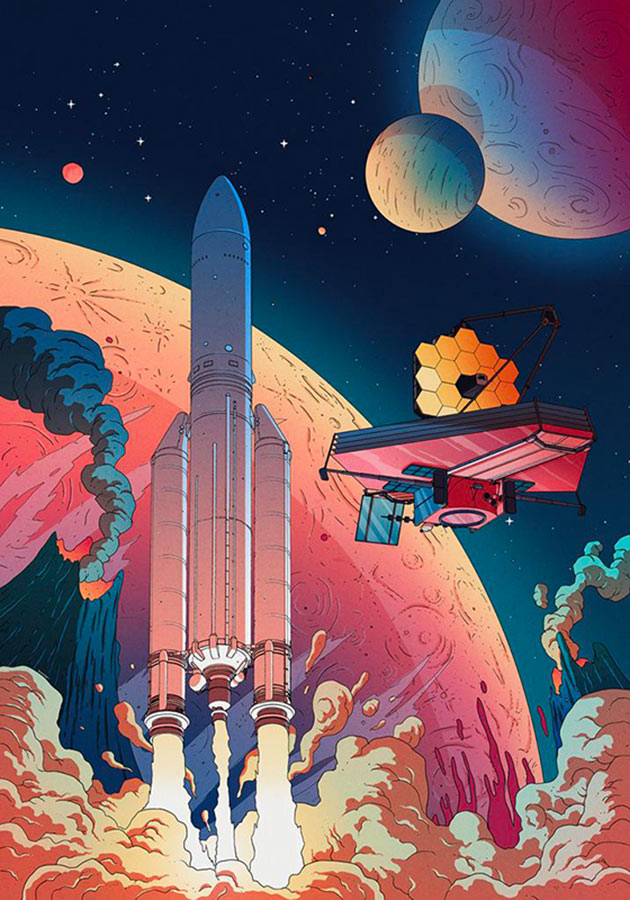The James Webb Space Telescope and Ariane 5 seen by Olivier Bonhomme
06.01.2022

In an artistic joint project, the French illustrator portrays the last Ariane 5 mission: the launch of JWST
French illustrator and artistic director Olivier Bonhomme mostly works for news media (Le Monde, Washington Post, etc.). His illustrations have been published all over the world. He creates series of stories and artshow exhibitions. He also finds the time to play a mean jazz saxophone.

Your illustration focuses on the last Ariane 5 mission, the launch of the James Webb Space Telescope. Why this choice?
I’ve always had a keen interest in humanity’s great discoveries. Even though I’m somewhat of an amateur when it comes to astronomy, I was drawn right away to this new space mission. It entails wide-ranging logistics and technical feats that will be worth the likely revelations it will unveil. Such a context greatly fueled my creative process.
What do ArianeGroup, and space in general, mean to you?
As somewhat of a French chauvinist, the name Ariane elicits a certain sense of pride. In a more general sense, it is also important to recognize how long the European space exploration project has been going on and that it is seen as a gold standard. Plus, space also means infinite possibilities. It embodies both scientific rigor and metaphysical inspiration. That’s an interesting relationship when it comes to artistic creativity; restrictions vs. freedom, imagination vs. observational precision…
How did you go about this artistic collaboration? You most likely had to do research, in particular to portray the JWST?
Yes, I thoroughly studied the launch process, the structure of each element, etc. Nevertheless, it was necessary to make decisions on how to portray them all in a single illustration. I chose to depict the telescope fully deployed: it’s a shape that has become part of our collective imagination.
Your compositions have a kind of surreal dimension. Objects seem to be floating, weightless. Can you tell us about this?
Surrealism is definitely a tool I use to juxtapose various elements in my illustrations and to spark the interest of viewers. It also helps me to prompt divergent, thought-provoking ideas that fuel the imagination… weightlessness, flight: they evoke that buoyant feeling associated with the imaginary; like a fetus in amniotic liquid or an astronaut in outer space.
Surrealism is definitely a tool I use to juxtapose different elements in my illustrations and to pique the curiosity of people looking at them. And I’d go further; it enables me to set up notions that bounce off each other, contradict, question, fuel the imagination… weightlessness, flight… these are the essence of the imagination; like a fetus in amniotic liquid or an astronaut in space.
Classical masters seems to be very important to you (Hopper, Hokusai). What do these interpretations tell us about our human culture?
I think that throughout the history of art, there has always been a connection between artists and scientific pioneers. Every period has its place in the continually-evolving history of humanity and I don’t believe that it is anachronistic to draw inspiration from art from a particular period and to retranslate it following one’s own modern interpretation. It’s a healthy continuum of our history.
You often use a wide variety of striking colors in your artworks. What does color mean to you?
To me, color is self-evident, an element in its own right. I think that to portray a “void”, one must actually fill it, adding colors and shapes. A void is a sort of mysterious space tingling with information. Our imagination fills the gaps our eyes don’t see with colors.